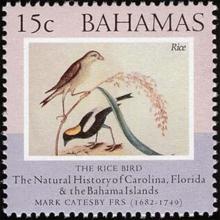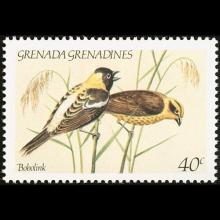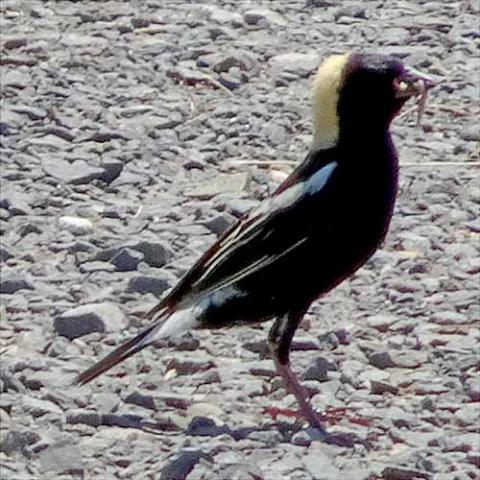NAMES
TAXONOMY
The Bahamas
Issued:
Stamp:
Dolichonyx oryzivorus
Grenada
Issued:
Stamp:
Dolichonyx oryzivorus
The Bahamas
Issued:
Stamp:
Dolichonyx oryzivorus
Grenada
Issued:
Stamp:
Dolichonyx oryzivorus
The Bahamas
Issued:
Stamp:
Dolichonyx oryzivorus
Grenada
Issued:
Stamp:
Dolichonyx oryzivorus
Link (in a new tab) to recordings of: Dolichonyx oryzivorus (Bobolink) at https://xeno-canto.org
Genus species (Animalia): Dolichonyx oryzivorus
The bobolink (Dolichonyx oryzivorus) is a small New World blackbird and the only member of the genus Dolichonyx. An old name for this species is the "rice bird", from its tendency to feed on cultivated grains. Adults are 16–18 cm (6.3–7.1 in) long with short finch-like bills and weigh about 28 g (1 oz). Adult males are mostly black with creamy napes and white scapulars, lower backs, and rumps. Adult females are mostly light brown with black streaks on the back and flanks, and dark stripes on the head; their wings and tails are darker. The bobolink breeds in the summer in Northern America, with most of the summer range in southern Canada, often wintering in South America. Considered a pest by some farmers, the numbers of these birds are declining and are a species at risk throughout Canada.
Etymology
The genus name Dolichonyx is from Ancient Greek dolikhos, "long", and onux, "claw". The specific oryzivorus is from Latin oryza, "rice", and vorare, "to devour"; an old name for this species is "Rice Bird". The English "Bobolink" is from Bob o' Lincoln, describing the call.
Description
Measurements:
- Length: 5.9–8.3 in (15–21 cm)
- Weight: 1.0–2.0 oz (28–57 g)
- Wingspan: 10.6 inches (27 cm)
Adults have short finch-like bills. Adult males are mostly black with creamy napes and white scapulars, lower backs, and rumps. Adult females and non-breeding males are mostly light brown, although their coloring includes black streaks on the back and flanks, and dark stripes on the head; their wings and tails are darker. The collective name for a group of bobolinks is a chain.
Distribution and movement
The bobolink breeds in the summer in North America across much of southern Canada and the northern United States; from 1966 to 2015 the species experienced a greater than 1.5% annual population decrease throughout most of its breeding range, extending from the Midwestern United States to the Canadian maritimes. The boblink migrates long distances, wintering in southern South America. One bird was tracked migrating 12,000 mi (19,000 km) over the course of the year, often flying long distances up to 1,100 mi (1,800 km) in a single day, then stopping to recuperate for days or weeks.
Bobolinks often migrate in flocks, feeding on cultivated grains and rice, which leads to them being considered a pest by farmers in some areas. Although bobolinks migrate long distances, they have rarely been sighted in Europe—like many vagrants from the Americas, the majority of records are from the British Isles.
The species has been known in the southern United States as the "reedbird," or the "ricebird" from their consumption of large amounts of the grain from rice fields in South Carolina and the Gulf States during their southward migration in the fall. One of the species' main migration routes is through Jamaica, where they are called "butter-birds" and at least historically were collected as food, having fattened up on the aforementioned rice.
Behavior
Breeding
Their breeding habitats are open grassy fields, especially hay fields, across North America. In high-quality habitats, males are often polygynous. Females lay five to six eggs in a cup-shaped nest, which is always situated on the ground and is usually well-hidden in dense vegetation. Both parents feed the young.
Feeding
Bobolinks forage on or near the ground, and mainly eat seeds and insects. They are nicknamed the "armyworm bird" because of their predation on armyworm moths such as the true armyworm moth (Mythimna unipuncta).
Calls
Males sing bright, bubbly songs in flight.
Status and conservation
The numbers of these birds are declining due to loss of habitat. Bobolinks are a species at risk in Nova Scotia, and throughout Canada. In Vermont, a 75% decline was noted between 1966 and 2007. Originally, they were found in tall grass prairie and other open areas with dense grass. Although hay fields are suitable nesting habitat, fields which are harvested early, or at multiple times, in a season may not allow sufficient time for young birds to fledge. Delaying hay harvests by just 1.5 weeks can improve bobolink survival by 20%. This species increased in numbers when horses were the primary mode of transportation, requiring larger supplies of hay.



